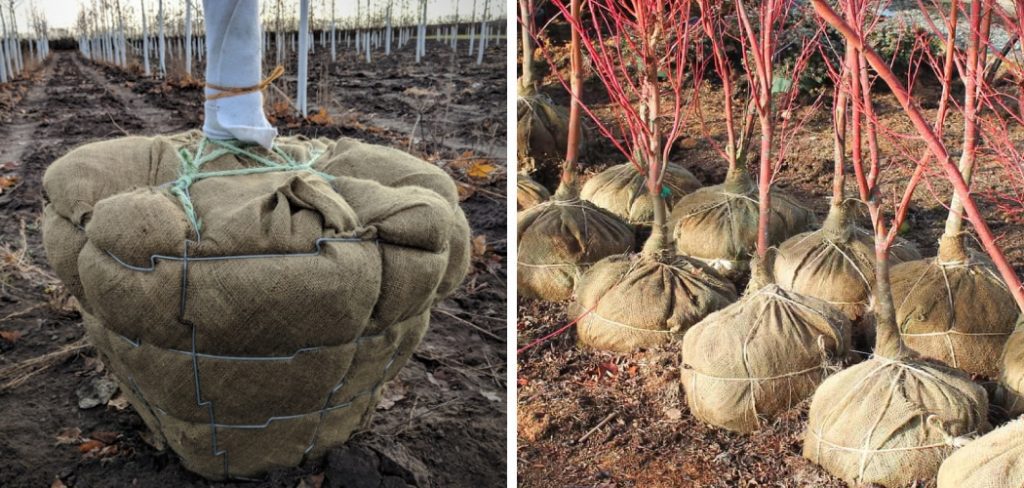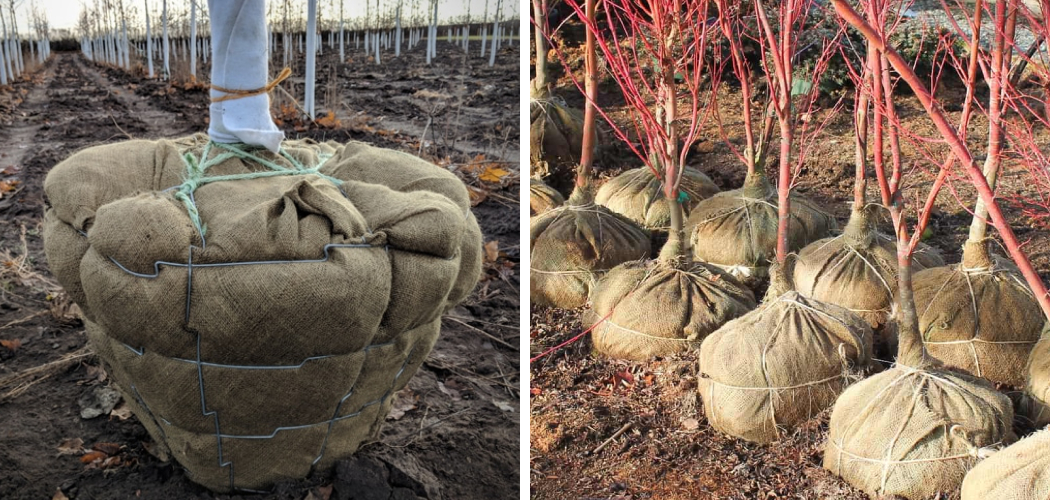To ball and burlap a tree, start by digging a hole wide and shallow enough to accommodate the tree’s root ball. Then, carefully lift the tree and place it into the hole, making sure the root ball is level with the ground.
Finally, fill in the hole with soil, firmly pressing it around the root ball to eliminate air pockets and promote stability. Water the tree thoroughly after planting to ensure proper hydration. Ball and burlap is a common method used to transplant trees while minimizing root disturbance, and following these steps will help ensure the tree’s successful establishment in its new location.

How to Ball And Burlap a Tree: Step by Step Guide
Choosing The Right Tree For Ball And Burlap
Choosing the right tree for a ball and burlap technique requires careful consideration of various factors. Firstly, you need to consider the specific tree species suitable for ball and burlap. Certain trees adapt better to this method due to their root systems and tolerance to transplanting.
Secondly, assess the size of the tree and its compatibility with the available space. Ensure that it won’t outgrow the area or cause obstructions in the future. Additionally, take into account the environmental conditions, such as sunlight, soil type, and climate, as they play a crucial role in the tree’s growth and longevity.
Lastly, consider the purpose of the tree— whether for shade, aesthetic appeal, or as a windbreak— to align with your overall landscaping goals. By carefully considering these factors, you can select the perfect tree for a successful ball and burlap process.
Preparing The Tree For Ball And Burlap
Preparing the tree for ball and burlap involves assessing its health and condition, pruning and shaping if needed, and tying up branches to make the process easier. By evaluating the tree’s overall well-being, we can ensure its successful transplantation. If there are any signs of disease or stress, it’s essential to address these issues before proceeding.
Additionally, pruning and shaping the tree allows for better root development and a more attractive appearance post-transplantation. Tying up branches also prevents damage during the ball and burlap process, reducing the risk of breakage. Taking these steps will help ensure the tree’s survival and flourishing once it’s relocated to its new home.
Digging And Wrapping The Root Ball
Digging the hole and loosening the soil is the first step in ball and burlap. Carefully determine the appropriate size of the root ball before starting the process. Once the hole is ready, remove the tree from its current location.
Be cautious not to damage the roots while doing this. Once the tree is out, secure the root ball with burlap and twine. Make sure it is tightly wrapped to ensure the safety of the roots. This method is commonly used for transplanting trees and helps in preserving their root system.
Ball and burlap is a reliable technique that allows for successful relocation of trees while minimizing stress on the plant.
Transplanting The Tree
Transplanting a tree involves planning the new planting location, digging and preparing the new site carefully. The hole must be dug according to the size of the tree’s ball and burlap. Once the hole is ready, the next step is placing the tree properly in the hole, ensuring it is straight and at the right height.
Backfilling the hole with soil and tamping it firmly around the root ball is crucial for stability. After transplanting, the newly planted tree should be watered thoroughly to eliminate air pockets and promote root establishment. Applying a layer of mulch around the tree helps retain moisture and suppress weed growth.
Following these steps ensures a successful ball and burlap tree transplanting process.
Aftercare And Maintenance
Aftercare and maintenance of ball and burlap trees are crucial for their survival. Providing adequate water and nutrients is essential. Monitoring the tree for signs of stress or disease ensures early intervention. Protecting the tree from extreme weather conditions, such as strong winds or frost, safeguards its health.
Regular pruning and shaping help maintain the tree’s form and promote healthy growth. Remember to remove dead or damaged branches to prevent further issues. By following these practices, you can ensure the longevity and beauty of your ball and burlap tree.
Frequently Asked Questions On How To Ball And Burlap A Tree
Q: Why Is It Important To Ball And Burlap A Tree?
A: ball and burlap is important to protect the tree’s roots during transportation and planting, ensuring its survival. The roots are kept intact, preventing damage and allowing the tree to establish itself faster in its new location.
Q: How Is The Ball And Burlap Technique Performed?
A: the ball and burlap technique involves digging a hole around the tree, carefully extracting it with its root ball intact. The root ball is then wrapped with burlap and secured with twine. This method ensures minimal root disturbance and preserves the tree’s health.
Q: When Is The Best Time To Ball And Burlap A Tree?
A: the best time to ball and burlap a tree is during its dormant season, typically in late fall or early spring. This allows the tree to be transplanted when it is in a dormant state, minimizing shock and promoting successful establishment in its new location.
Q: Can Any Type Of Tree Be Ball And Burlap?
A: most types of trees can be ball and burlap, but certain species with sensitive root systems may not tolerate the process well. It is important to consult with a professional arborist to determine if ball and burlap is suitable for the specific tree species.
Q: How Long Does A Tree Take To Recover After Being Ball And Burlap?
A: the recovery time for a tree after being ball and burlap varies depending on factors such as tree species, size, and environmental conditions. Generally, it may take several months to a year for the tree to fully recover and establish itself in its new location.
Q: Can Ball And Burlap Be Done On Mature Trees?
A: ball and burlap can be done on mature trees, but it becomes more challenging as the tree’s size and root spread increase. It is crucial to engage professional services to ensure proper techniques are used to minimize any potential damage to the tree during the process.
Conclusion
To successfully ball and burlap a tree, it is essential to follow the proper techniques and guidelines. By carefully considering the tree’s size and health, preparing the root ball, and utilizing the right materials, you can ensure a successful transplantation process.
Remember to take into account the weather conditions, as planting during optimal weather conditions greatly increases the chances of survival for the tree. Additionally, always handle the tree with care to prevent any root damage during transportation. Once the tree is successfully ball and burlapped, ensure that it is planted promptly and in the appropriate location.
By adhering to these guidelines and paying attention to detail, you can successfully ball and burlap a tree, giving it a better chance of thriving in its new environment.

